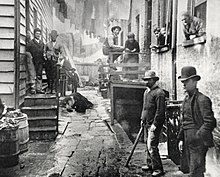User:Tomskyhaha/sandbox
test
Life[edit]
Childhood[edit]

George Appo's father was Lee Ah Bow, alias Quimbo Appo (ca. 1825–1912).[1] a migrant from the Chinese province of Zhejiang, who came to San Francisco in 1847 and was therefore one of the earliest Chinese migrants in this city. In 1849 Quimbo traveled to the East Coast of the United States as a gold prospector[2] , where he settled in Boston, New York and New Haven. In 1854 he married with Catherine Fitzpatrick, an Irish American of Dublin origin. In 1856, a few weeks after the birth of their child, George, the family moved to Five Points, Manhattan, a slum neighborhood. Here Quimbo worked as a tea house servant.[3][4]
In 1859, when George was only 2 years old, his father had an argument with his drunken mother, killed the landlord in a fight and injuring two neighbors. Quimbo Appo was at first sentenced to death. In a second trial the sentencing was reduced to 10 years in prison. He was released after 4 years. George's mother escaped with his younger sister to California and lost their lives in a ship accident. George Appo was left alone in New York.[5]
After two more murders, numerous violent acts and long hard labor prison terms, Quimbo Appo became the most notorious Chinese in the city, know as "Chinese Devil Man" and "Devil Appo“. He ended up in Matteawan State Hospital for the Criminally Insane, where he, psychologically confused, died in 1912.[1]
George Appo wuchs deshalb ohne seine Familie im Slum von Five Points auf. In der heute nicht mehr existierenden Donovan’s Lane, genannt „Mördergasse“, der schäbigsten Straße in den Five Points,[6] kam er die nächsten Jahre bei einer fremden Familie unter. „Ich wurde nicht großgezogen, sondern großgeprügelt“, sagte Appo später dazu.[7] Eine Schule besuchte er nie. Seine begrenzten Lese- und Schreibfähigkeiten erwarb er bei späteren Gefängnisaufenthalten von Mithäftlingen.[5]
- ^ a b John Kuo Wei Tchen: Quimbo Appo's Fear of Fenians. In: Ronald H. Bayor, Timothy J. Meagher (Hrsg.): The New York Irish. Baltimore, London 1996, S. 125–152.
- ^ Cite error: The named reference
Gilfoyle 3was invoked but never defined (see the help page). - ^ The New York Times v. 26. Dezember 1856 (PDF).
- ^ Robert G. Lee: Orientals. Asian Americans in Popular Culture. Philadelphia 1999, S. 81f.
- ^ a b Frank Moss: George Appo, a Child of the Slums. In: Ders.: The American Metropolis. Vol. 3. New York 1897, S. 118–141 (based on an autobiographical Text by Appo) (Digitalisat).
- ^ vgl. George David Brown: The Opium-Smokers of Donovan's Lane. In: Appletons' Journal 10 (1873), S. 270–273.
- ^ The New York Times v. 8. Oktober 1894 (PDF).

